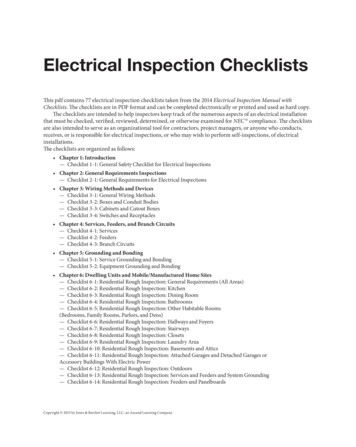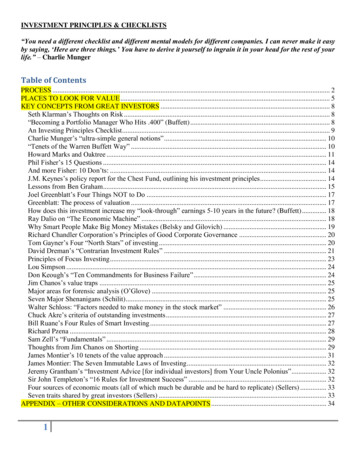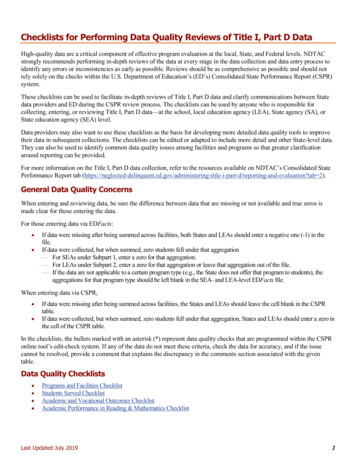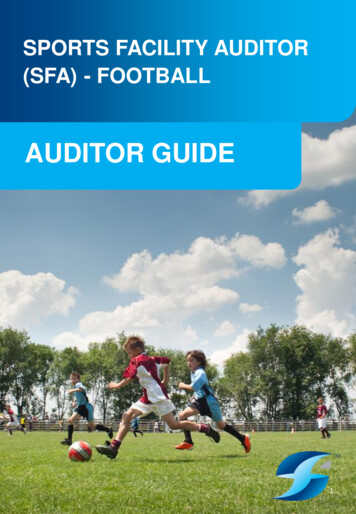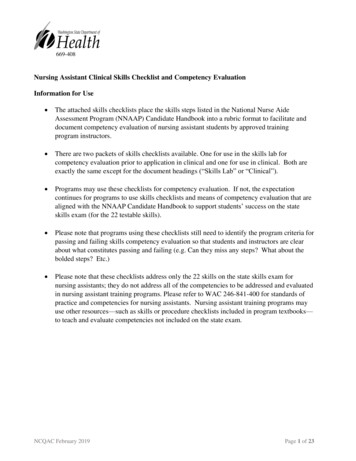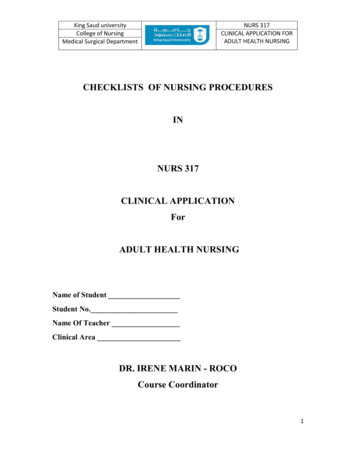
Transcription
King Saud universityCollege of NursingMedical Surgical DepartmentNURS 317CLINICAL APPLICATION FORADULT HEALTH NURSINGCHECKLISTS OF NURSING PROCEDURESINNURS 317CLINICAL APPLICATIONForADULT HEALTH NURSINGName of StudentStudent No.Name Of TeacherClinical AreaDR. IRENE MARIN - ROCOCourse Coordinator1
King Saud universityCollege of NursingMedical Surgical DepartmentNURS 317CLINICAL APPLICATION FORADULT HEALTH NURSINGCHECKLISTS OF NURSING PROCEDURESNote: Students are REQUIRED to perform at least five (5) Nursing Procedures within thesemester1. Performing General Physical Assessment2. Teaching a Patient to Use an Incentive Spirometer3. Administering Medication via metered Dose Inhaler (MDI)4. Caring For A Patient Receiving Patient Controlled Analgesia5. Providing Preoperative Patient Care: Hospitalized Patient6. Providing Preoperative Patient Care: Day of Surgery7. Providing postoperative Patient Care When Patient Returns to Room8.9.10.11.12.Obtaining Capillary Blood Sample for Glucose TestingObtaining an Electrocardiogram (ECG) MonitoringAdministering a Blood TransfusionChanging and Emptying an Ostomy ApplianceEmploying Seizure Precautions And Seizure Management2
King Saud universityCollege of NursingMedical Surgical DepartmentNURS 317CLINICAL APPLICATION FORADULT HEALTH NURSINGTEACHING A PATIENT TO USE AN INCENTIVE SPIROMETERName of StudentStudent No.DateName of TeacherLegend210Done CorrectlyDone with AssistanceNot doneEquipment: Incentive Spirometer Stethoscope Folded Blanket Or Pillow For Splinting Of Chest Or Abdominal Incision PPEGoal: The patient accurately demonstrates the procedure for using the cedureReview chart for any health problems that would affect the patient’soxygenation statusBring necessary equipment to the bedside stand or overbed table.Perform hand hygiene and put on PPE, if indicatedIdentify the patient . Close curtains around bed and close the door tothe room, if possible.Explain what you are going to do and why you are going to do it to thepatientAssist patient to an upright or semi-Fowler’s position, if possible.Remove dentures if they fit poorly.Assess the patient’s level of pain. Administer pain medication, asprescribed, if needed. Wait the appropriate amount of time for themedication to take effect. If patient has recently undergoneabdominal or chest surgery, place a pillow or folded blanket over achest or abdominal incision for splintingDemonstrate how to steady the device with one hand and hold themouthpiece with the other hand. If the patient cannot use hands,assist the patient with the incentive spirometer.Instruct the patient to exhale normally and then place lips securelyaround the mouthpieceInstruct patient to inhale slowly and as deeply as possible through themouthpiece without using nose (if desired, a nose clip may be used).When the patient cannot inhale anymore, the patient should hold hisor her breath and count to three. Check position of gauge to3
King Saud universityCollege of NursingMedical Surgical DepartmentNURS 317CLINICAL APPLICATION FORADULT HEALTH NURSINGScore12.13.14.15.RemarksProceduredetermine progress and level attained. If patient begins to cough,splint an abdominal or chest incision.Instruct the patient to remove lips from mouthpiece and exhalenormally. If patient becomes light-headed during the process, tell himor her to stop and take a few normal breaths before resumingincentive spirometry.Encourage patient to perform incentive spirometry 5 to 10 timesevery 1 to 2 hours, if possible.Clean the mouthpiece with water and shake to dry.Remove PPE, if used. Perform hand hygieneTOTAL SCORE : 15X2 30 ptsReference: Pamela Lynn and Marilee LeBon. Skill Checklists for Taylor’s Clinical Nursing Skills:A Nursing Process Approach, 3rd edition, by Wolters Kluwer Health Lippincott Williams &Wilkins. 2011.SCORING OF PERFORMANCEScore24.2- 3018.4- 24.112.6- 18.31.812.51.0 – 6.7Level of PerformanceExcellentVery GoodGoodFairPoorMarks54321Evaluator’s Name:Signature:4
King Saud universityCollege of NursingMedical Surgical DepartmentNURS 317CLINICAL APPLICATION FORADULT HEALTH NURSINGADMINISTERING MEDICATION VIA METERED DOSE INHALER (MDI)Name of StudentStudent No.DateName of TeacherLegend210Done CorrectlyDone with AssistanceNot doneEquipment: Incentive Spirometer Stethoscope Folded Blanket Or Pillow For Splinting Of Chest Or Abdominal Incision PPE Medication in an MDI Spacer or holding chamber Medication administration recordGoal: The patient receives the medication via an inhaler using the correct techniqueScoreRemarksProcedure1. Gather equipment. Check each medication order against the originalorder in the medical record, according to facility policy. Clarify anyinconsistencies. Check the patient’s chart for allergies.2. . Know the actions, special nursing considerations, safe dose ranges,purpose of administration, and adverse effects of the medications to beadministered. Consider the appropriateness of the medication for thispatient3. Perform hand hygiene4. Move the medication cart to the outside of the patient’s room orprepare for administration in the medication area5. Unlock the medication cart or drawer. Enter pass code and scanemployee identification, if required6. . Prepare medications for one patient at a time.7. Read the CMAR/MAR and select the proper medication from thepatient’s medication drawer or unit stock.8. Compare the label with the CMAR/MAR. Check expiration dates andperform calculations, if necessary. Scan the bar code on the package, ifrequired9. When all medications for one patient have been prepared, recheck thelabel with the MAR before taking them to the patient.10. Lock the medication cart before leaving it.11. Transport medications to the patient’s bedside carefully, and keep themedications in sight at all times12. Ensure that the patient receives the medications at the correct time.13. Perform hand hygiene and put on PPE, if indicated.5
King Saud universityCollege of NursingMedical Surgical DepartmentNURS 317CLINICAL APPLICATION FORADULT HEALTH NURSINGScoreRemarksProcedure14. Identify the patient. Usually, the patient should be identified using twomethods. Compare information with the CMAR/ MAR.a. Check the name and identification number on the patient’sidentification band.b. Ask the patient to state his or her name and birth date, basedon facility policy.c. If the patient cannot identify him- or herself, verify the patient’sidentification with a staff member who knows the patient forthe second source15. Complete necessary assessments before administering medications.Check the patient’s allergy bracelet or ask the patient about allergies.16. Explain what you are going to do and the reason to the patient17. Scan the patient’s bar code on the identification band, if required18. Remove the mouthpiece cover from the MDI and the spacer. Attachthe MDI to the spacer.19. Shake the inhaler and spacer well.20. Have patient place the spacer’s mouthpiece into mouth, graspingsecurely with teeth and lips. Have patient breathe normally throughthe spacer21. Patient should depress the canister, releasing one puff into the spacer,then inhale slowly and deeply through the mouth22. . Instruct patient to hold his or her breath for 5 to 10 seconds, or aslong as possible, and then to exhale slowly through pursed lips.23. Wait 1 to 5 minutes, as prescribed, before administering the next puff.24. . After the prescribed amount of puffs has been administered, havepatient remove the MDI from the spacer and replace the caps onboth.25. Have the patient gargle and rinse with tap water after using an MDI,as necessary. Clean the MDI according to the manufacturer’sdirections26. Remove gloves and additional PPE, if used. Perform hand hygiene27. Document the administration of the medication immediately afteradministration.28. Evaluate the patient’s response to medication within appropriate timeframe. Reassess lung sounds, oxygenation saturation if ordered, andrespirationsTOTAL SCORE : 28 X 2 56 ptsReference: Pamela Lynn and Marilee LeBon. Skill Checklists for Taylor's Clinical Nursing Skills: A Nursing ProcessApproach, 3rd edition, by Wolters Kluwer Health Lippincott Williams & Wilkins. 2011.SCORING OF PERFORMANCEScoreLevel of PerformanceMarks45 - 56Excellent534 – 44Very Good423 – 33Good312 – 22Fair21- 11Poor1Evaluator’s Name: Signature:6
King Saud universityCollege of NursingMedical Surgical DepartmentNURS 317CLINICAL APPLICATION FORADULT HEALTH NURSINGCARING FOR A PATIENT RECEIVING PATIENT CONTROLLED ANALGESIAName of StudentStudent No.DateName of TeacherEquipment : PCA systemSyringe filled with medicationPCA system tubingAlcohol SwabsGoal: The patient reports increased comfort and decreased pain; and shows no signs of adverse effects,oversedation, or respiratory depression.Legend210Done CorrectlyDone with AssistanceNot doneScoreRemarksProcedure1. Gather equipment . Check the medication order against the originalphysician’s order according to agency policy. Clarify any inconsistencies.Check the patient’s chart for allergies2. Know the actions, special nursing considerations, safe dose ranges,purpose of administration, and adverse effects of the medications to beadministered. Consider the appropriateness of the medication for thispatient.3. Prepare the medication syringe or other container, based on facilitypolicy, for administration4. Perform hand hygiene and put on PPE, if indicated5. Identify the patient6. Show the patient the device, and explain its function and the reason foruse. Explain the purpose and action of the medication to the patient7. . Plug the PCA device into the electrical outlet, if necessary. Check statusof battery power, if appropriate8. Close the door to the room or pull the bedside curtain9. Complete necessary assessments before administering medication.Check allergy bracelet or ask patient about allergies. Assess the patient’spain, using an appropriate assessment tool and measurement scale.10.Check the label on the prefilled drug syringe with the medicationrecord and patient identification. Obtain verification of information froma second nurse, according to facility policy. If using a barcodeadministration system, scan the barcode on the medication label, ifrequired11. If using a barcode administration system, scan the patient’sbarcode on the identification band, if required7
King Saud universityCollege of NursingMedical Surgical DepartmentNURS 317CLINICAL APPLICATION FORADULT HEALTH NURSINGScoreRemarksProcedure12.Connect tubing to prefilled syringe and place the syringe into thePCA device. Prime the tubing.13.Set the PCA device to administer the loading dose, if ordered, andthen program the device based on the medical order for medicationdosage, dose interval, and lockout interval. Obtain verification ofinformation from a second nurse, according to facility policy14.Put on gloves. Using antimicrobial swab, clean connection port onIV infusion line or other site access, based on route of administration.Connect the PCA tubing to the patient’s IV infusion line or appropriateaccess site, based on the specific site used. Secure the site per facilitypolicy and procedure. Remove gloves. Initiate the therapy by activatingthe appropriate button on the pump. Lock the PCA device, per facilitypolicy15.Remind the patient to press the button each time he or she needsrelief from pain16.Assess the patient’s pain at least every 4 hours or more often, asneeded. Monitor vital signs, especially respiratory status, includingoxygen saturation at least every 4 hours or more often as needed17.Assess the patient’s sedation score and end-tidal carbon dioxidelevel (capnography) at least every 4 hours or more often as needed18.Assess the infusion site periodically, according to facility policy andnursing judgment. Assess the patient’s use of the medication, notingnumber of attempts and number of doses delivered. Replace the drugsyringe when it is empty.19.Make sure the patient control (dosing button) is within thepatient’s reach20.Remove gloves and additional PPE, if used. Perform hand hygiene.TOTAL SCORE : 20 X 2 40 ptsReference: Pamela Lynn and Marilee LeBon. Skill Checklists for Taylor's Clinical Nursing Skills:A Nursing Process Approach, 4rd edition, by Wolters Kluwer Health Lippincott Williams &Wilkins. 2015.SCORING OF PERFORMANCEScore32.4 – 4024.4 – 32.116.6 – 24.38.8 – 16.51.0 - 8.7Evaluator’s Name:Level of PerformanceExcellentVery GoodGoodFairPoorMarks54321Signature:8
King Saud universityCollege of NursingMedical Surgical DepartmentNURS 317CLINICAL APPLICATION FORADULT HEALTH NURSINGPROVIDING PREOPERATIVE PATIENT CARE: HOSPITALIZED PATIENTName of StudentDateStudent No.Name of TeacherEquipment: BP Apparatus Stethoscope Thermometer Pulse Oximeter sensors IV pump, IV Solution Graduated compression stockings Tubes, drains Vascular access tubings Incentive spirometer Small pillow PPEGoal: The patient proceeds to surgery physically and psychologically prepared.Legend210Done CorrectlyDone with AssistanceNot doneScore1.2.3.4.5.6.7.RemarksProcedureCheck the patient’s chart for the type of surgery and review the medicalorders. Review the nursing database, history, and physical examination.Check that the baseline data are recorded; report those that are abnormal.Check that diagnostic testing has been completed and results are available;identify and report abnormal resultsGather the necessary supplies and bring to the bedside stand or overbedtable.Perform hand hygiene and put on PPE, if indicated.Identify the patientClose curtains around bed and close the door to the room, if possible.Explain what you are going to do and why you are going to do it to thepatient.Explore the psychological needs of the patient related to the surgery aswell as the family.a. Establish the therapeutic relationship, encouraging the patient toverbalize concerns or fears.b. Use active learning skills, answering questions and clarifying anymisinformation.9
King Saud universityCollege of NursingMedical Surgical DepartmentNURS 317CLINICAL APPLICATION FORADULT HEALTH NURSINGScoreRemarksProcedurec. Use touch, as appropriate, to convey genuine empathyd. Offer to contact spiritual counselor (priest, minister, rabbi) to meetspiritual needs.8. Identify learning needs of patient and family. Ensure that the informedconsent of the patient for the surgery has been signed, witnessed, anddated.9. Inquire if the patient has any questions regarding the surgical procedure.10. Check the patient’s record to determine if an advance directive has beencompleted. If an advance directive has not been completed, discuss withthe patient the possibility of completing it, as appropriate. If patient hashad surgery before, ask about this experience11. . Provide teaching about deep breathing exercises12. Provide teaching regarding coughing and splinting (providing support tothe incision13. Provide teaching regarding incentive spirometer14. Provide teaching regarding leg exercises, as appropriate.15. Assist the patient in putting on antiembolism stockings and demonstratehow the pneumatic compression device operates16. Provide teaching regarding turning in the bed.a. Instruct the patient to use a pillow or bath blanket to splint where theincision will be. Ask the patient to raise his or her left knee and reachacross to grasp the right side rail of the bed when turning toward his orher right side. If patient is turning to his or her left side, he or she willbend the right knee and grasp the left side rail.b. When turning the patient onto his or her right side, ask the patient topush with bent left leg and pull on the right side rail. Explain to patientthat you will place a pillow behind his/her back to provide support, andthat the call bell will be placed within easy reach.c. Explain to the patient that position change is recommended every 2hours.17. Provide teaching about pain management.a. Discuss past experiences with pain and interventions that the patienthas used to reduce pain.b. Discuss the availability of analgesic medication postoperatively.c. Discuss the use of patient controlled analgesia (PCA), as appropriated. Explore the use of other alternative and nonpharmacologic methods toreduce pain, such as position change, massage, relaxation/diversion,guided imagery, and meditation.18. Review equipment that may be used. a. Show the patient variousequipment, such as IV pumps, electronic blood pressure cuff, tubes, andsurgical drains19. Provide skin preparation. a. Ask the patient to bathe or shower with theantiseptic solution. Remind the patient to clean the surgical site20. Provide teaching about and follow dietary/fluid restrictions.10
King Saud universityCollege of NursingMedical Surgical DepartmentNURS 317CLINICAL APPLICATION FORADULT HEALTH NURSINGScoreRemarksProcedurea. Explain to the patient that both food and fluid will be restricted beforesurgery to ensure that the stomach contains a minimal amount of gastricsecretions. This restriction is important to reduce the risk of aspiration.21. Emphasize to the patient the importance of avoiding food and fluids duringthe prescribed time period, because failure to adhere may necessitatecancellation of the surgery22. Provide intestinal preparation, as appropriate. In certain situations, thebowel will need to be prepared by administering enemas or laxatives toevacuate the bowel and to reduce the intestinal bacteria.a. As needed, provide explanation of the purpose of enemas or laxativesbefore surgery. If patient will be administering an enema, clarify thesteps as needed.23. Check administration of regularly scheduled medications.24. Review with the patient routine medications, over-the countermedications, and herbal supplements that are taken regularly.25. Check the physician’s orders and review with the patient whichmedications he or she will be permitted to take the day of surgery.26. Remove PPE, if used. Perform hand hygiene.TOTAL SCORE : 28X 2 56ptsReference: Pamela Lynn and Marilee LeBon. Skill Checklists for Taylor's Clinical Nursing Skills: A NursingProcess Approach, 4rd edition, by Wolters Kluwer Health Lippincott Williams & Wilkins. 2015.SCORING OF PERFORMANCEScore45 – 5634. – 44.923 – 33.91.122.91.00 – 11.9Level of PerformanceExcellentVery GoodGoodFairPoorMarks54321Evaluator’s Name:Signature:11
King Saud universityCollege of NursingMedical Surgical DepartmentNURS 317CLINICAL APPLICATION FORADULT HEALTH NURSINGPROVIDING PREOPERATIVE PATIENT CARE: HOSPITALIZED PATIENT (DAY OF SURGERY)Name of StudentStudent No.DateName of TeacherLegend210Done CorrectlyDone with AssistanceNot doneEquipment: BP Apparatus Stethoscope Thermometer Pulse Oximeter sensors IV pump, IV Solution Graduated compression stockings Tubes, drains Vascular access tubings Incentive spirometer Small pillow PPEGoal: The patient will be prepared physically and psychologically to proceed to surgery.ScoreRemarksProcedure1. Check the patient’s chart for the type of surgery and review themedical orders. Review the nursing database, history, and physicalexamination. Check that the baseline data are recorded; report thosethat are abnormal2. Gather the necessary supplies and bring to the bedside stand oroverbed table3. Perform hand hygiene and put on PPE, if indicated. 4. Identify thepatient4. Close curtains around bed and close the door to the room, if possible.Explain what you are going to do and why you are going to do it to thepatient5. Check that preoperative consent forms are signed, witnessed, andcorrect; that advance directives are in the medical record (asapplicable); and that the patient’s chart is in order.6. Check vital signs. Notify primary care provider and surgeon of anypertinent changes (e.g., rise or drop in blood pressure, elevatedtemperature, cough, symptoms of infection).7. Provide hygiene and oral care. Assess for loose teeth and caps. Remindpatient of food and fluid restrictions before surgery.12
King Saud universityCollege of NursingMedical Surgical DepartmentNURS 317CLINICAL APPLICATION FORADULT HEALTH NURSINGScoreRemarksProcedure8. Instruct the patient to remove all personal clothing, includingunderwear, and put on a hospital gown9. Ask patient to remove cosmetics, jewelry including body piercing, nailpolish, and prostheses (e.g., contact lenses, false eyelashes, dentures,and so forth). Some facilities allow a wedding band to be left in placedepending on the type of surgery, provided it is secured to the fingerwith tape10. If possible, give valuables to family member or place valuables inappropriate area, such as the hospital safe, if this is not possible.They should not be placed in narcotics drawer.11. Have patient empty bladder and bowel before surgery.12. Attend to any special preoperative orders, such as starting an IV line.13. . Complete preoperative checklist and record of patient’spreoperative preparation14. Question patient regarding the location of the operative site.Document the location in the medical record according to facilitypolicy. The actual site will be marked on the patient when the patientarrives in the preoperative holding area by the licensed independentpractitioner who will be directly involved in the procedure15. . Administer preoperative medication as prescribed byphysician/anesthesia provider16. Raise side rails of bed; place bed in lowest position. Instruct patientto remain in bed or on stretcher. If necessary, use a safety belt.17. Help move the patient from the bed to the transport stretcher, ifnecessary. Reconfirm patient identification and ensure that allpreoperative events and measures are documented.18. Tell the patient’s family where the patient will be taken after surgeryand the location of the waiting area where the surgeon will come toexplain the outcome of the surgery. If possible, take the family to thewaiting area.19. After the patient leaves for the operating room, prepare the roomand make a postoperative bed for the patient. Anticipate anynecessary equipment based on the type of surgery and the patient’shistory.20. Remove PPE, if used. Perform hand hygiene.TOTAL SCORE : 20 X 2 40 ptsReference: Pamela Lynn and Marilee LeBon. Skill Checklists for Taylor's Clinical Nursing Skills:A Nursing Process Approach, 4rd edition, by Wolters Kluwer Health Lippincott Williams &Wilkins. 2015.13
King Saud universityCollege of NursingMedical Surgical DepartmentNURS 317CLINICAL APPLICATION FORADULT HEALTH NURSINGSCORING OF PERFORMANCEScore32.4 – 4024.4 – 32.116.6 – 24.38.8 – 16.51.0 – 8.7Level of PerformanceExcellentVery GoodGoodFairPoorMarks54321Evaluator’s Name: Signature:14
King Saud universityCollege of NursingMedical Surgical DepartmentNURS 317CLINICAL APPLICATION FORADULT HEALTH NURSINGPROVIDING POSTOPERATIVE PATIENT CARE WHEN PATIENT RETURNS TO ROOMName of StudentDateStudent No.Name of TeacherLegend210Done CorrectlyDone with AssistanceNot doneEquipment: BP Apparatus Stethoscope Thermometer Pulse Oximeter sensors IV pump, IV Solution Graduated compression stockings Tubes, drains Vascular access tubings Incentive spirometer Small pillow PPE BlanketsGoal: The patient will recover from the surgery with postoperative risks minimized by frequentassessments.ScoreRemarksProcedureImmediate Care1. When patient returns from the PACU, obtain a report from thePACU nurse and review the operating room and PACU data2. Perform hand hygiene and put on PPE, if indicated3. Identify the patient. Close curtains around bed and close the door tothe room, if possible. Explain what you are going to do and why youare going to do it to the patient4. Place patient in safe position (semi- or high Fowler’s or side-lying).Note level of consciousness5. Obtain vital signs. Monitor and record vital signs frequently.Assessment order may vary, but usual frequency includes taking vitalsigns every 15 minutes the first hour, every 30 minutes the next 2hours, every hour for 4 hours, and finally every 4 hours.15
King Saud universityCollege of NursingMedical Surgical DepartmentNURS 317CLINICAL APPLICATION FORADULT HEALTH NURSINGScoreRemarksProcedure6. Assess the patient’s respiratory status7. Measure the patient’s oxygen saturation level. 8. Assess the patient’scardiovascular status8. Assess the patient’s neurovascular status, based on the type ofsurgery performed.9. Provide for warmth, using heated or extra blankets, as necessary.Assess skin color and condition.10.Check dressings for color, odor, presence of drains, and amountof drainage. Mark the drainage on the dressing by circling theamount, and include the time.11.Turn the patient to assess visually under the patient forbleeding from the surgical site.12.Verify that all tubes and drains are patent and equipment isoperative; note amount of drainage in collection device. If anindwelling urinary (Foley) catheter is in place, note urinary output13.Verify and maintain IV infusion at correct rate14. Assess for pain and relieve it by administering medications orderedby the physician. If the patient has been instructed in use of PCAfor pain management, review its use. Check record to verify ifanalgesic medication was administered in the PACU.15. . Provide for a safe environment. Keep bed in low position withside rails up, based on facility policy. Have call bell within patient’sreach16. Remove PPE, if used. Perform hand hygiene.Ongoing Care17. Promote optimal respiratory function.a. Assess respiratory rate, depth, quality, color, and capillary refill.Ask if the patient is experiencing any difficulty breathing.b. Assist with coughing and deep breathing exercisesc. Assist with incentive spirometryd. Assist with early ambulation.e. Provide frequent position change.f. Administer oxygen as ordered.g. Monitor pulse oximetry18. Promote optimal cardiovascular function:a. Assess apical rate, rhythm, and quality and compare withperipheral pulses, color, and blood pressure. Ask if the patienthas any chest pains or shortness of breath.b. Provide frequent position changes.c. Assist with early ambulation.d. Apply antiembolism stockings or pneumatic compressiondevices, if ordered and not in place. If in place, assess forintegrity.e. Provide leg and range-of-motion exercises if not contraindicated19. Promote optimal neurologic function:a. Assess level of consciousness, motor, and sensation.b. Determine the level of orientation to person, place, and time.16
King Saud universityCollege of NursingMedical Surgical DepartmentNURS 317CLINICAL APPLICATION FORADULT HEALTH NURSINGScore20.21.22.23.RemarksProcedurec. Test motor ability by asking the patient to move each extremity.d. Evaluate sensation by asking the patient if he or she can feelyour touch on an extremity.Promote optimal renal and urinary function and fluid andelectrolyte status. Assess intake and output, evaluate for urinaryretention and monitor serum electrolyte levels.a. Promote voiding by offering bedpan at regular intervals, notingthe frequency, amount, and if any burning or urgency symptoms.b. Monitor urinary catheter drainage if present.c. Measure intake and output.Promote optimal gastrointestinal function and meet nutritionalneeds:a. Assess abdomen for distention and firmness. Ask if patient feelsnauseated, any vomiting, and if passing flatus.b. Auscultate for bowel sounds.c. Assist with diet progression; encourage fluid intake; monitorintake. D. Medicate for nausea and vomiting, as ordered byphysicianPromote optimal wound healing.a. Assess condition of wound for presence of drains and anydrainage. B. Use surgical asepsis for dressing changes.c. Inspect all skin surfaces for beginning signs of pressure ulcerdevelopment and use pressure-relieving supports to minimizepotential skin breakdownPromote optimal comfort and relief from pain.a. Assess for pain (location and intensity using scale).b. Provide for rest and comfort; provide extra blankets, as needed,for warmth.c. Administer pain medications, as needed, or othernonpharmacologic methods24. Promote optimal meeting of psychosocial needs:a. Provide emotional support to patient and family, as needed.b. Explain procedures and offer explanations regardingpostoperative recovery, as needed, to both patient and familymembers.TOTAL SCORE : 24X 2 48ptsReference: Pamela Lynn and Marilee LeBon. Skill Checklists for Taylor’s Clinical Nursing Skills: A NursingProcess Approach, 4rd edition, by Wolters Kluwer Health Lippincott Williams & Wilkins. 2015.SCORING OF PERFORMANCEScoreLevel of PerformanceMarks38.6 – 48Excellent529.2 – 38.5Very Good419.8 – 29.1Good310.4– 19.7Fair21.0 – 10.3Poor1Evaluator’s Name: Signature:17
King Saud universityCollege of NursingMedical Surgical DepartmentNURS 317CLINICAL APPLICATION FORADULT HEALTH NURSINGOBTAINING CAPILLARY BLOOD SAMPLE FOR GLUCOSE TESTINGBLOOD GLUCOSE MONITORING Provides information about how the body is controlling glucose metabolismPoint of care testing (testing done at the bedside, where samples re not sent to the lab) providesconvenient, rapid, and accurate measurement of blood GlucoseBlood samples are commonly obtained from the edges of the fingers for adults, but samples canbe obtained from the palm of the hand, forearm, upper arm, calf and anterior thigh, dependingon the time of testing and monitor used.Avoid fingertips because they are more sensitiveRotate site to prevent skin damage.It is important to be familiar with and follow the manufacturer’s guidelines and facility policy andprocedure to ensure accurate results.Normal fasting glucose for Adults is less than 110 mg/ dlEquipment: Blood glucose meter, Sterile lancet, cotton balls or gauze squares, testing strips formeter, non sterile gloves, additional PPE as indicated, Skin cleanser and water or alcohol swabAssessment: Assess the patient’s history for indications necessitating the monitoring of bloodglucose levels such as high carbohydrate feedings, hist
Reference: Pamela Lynn and Marilee LeBon. Skill Checklists for Taylor's Clinical Nursing Skills: A Nursing Process Approach, 3rd edition, by Wolters Kluwer Health Lippincott Williams & Wilkins. 2011. SCORING OF PERFORMANCE Score Level of Performance Marks 24.2- 30 Excellent 5 18.4- 24.1 Very Good 4 12.6- 18.3 Good 3
